Sensory Receptors, Neuronal Circuits for Processing Information
1/74
There's no tags or description
Looks like no tags are added yet.
Name | Mastery | Learn | Test | Matching | Spaced |
|---|
No study sessions yet.
75 Terms
TYPES OF SENSORY RECEPTOR AND STIMULI THEY DETECT
1 mechanoreceptors
Which detect mechanical compression or stretching of the receptor or of tissues adjacent to the receptor.
Examples
Skin tactile sensibilities (epidermis and dermis)
• Free nerve endings
• Expanded tip endings
Merkel's discs
Plus several other variants
• Spray endings
• Ruffini's endings
• Encapsulated endings
Meissner's corpuscles
Krause's corpuscles
• Hair end-organs
Deep tissue sensibilities
• Free nerve endings
• Expanded tip endings
• Spray endings
Ruffini's endings
• Encapsulated endings
Pacinian corpuscles
Plus a few other variants
• Muscle endings
Muscle spindles
Golgi tendon receptors
Hearing
• Sound receptors of cochlea
Equilibrium
• Vestibular receptors
Arterial pressure
• Baroreceptors of carotid sinuses and aorta
2 thermoreceptors
Which detect changes in temperature, with some receptors detecting cold and others detecting warmth.
Examples
Cold
• Cold receptors
Warmth
• Warm receptors
3 nociceptors (pain receptors)
Which detect physical or chemical damage occurring in the tissues
Examples
Pain
• Free nerve endings
4 electromagnetic receptors
Which detect light on the retina of the eye.
Examples
Vision
• Rods
• Cones
5. Chemoreceptors
Which detect taste in the mouth, smell in the nose, oxygen level in the arterial blood, osmolality of the body fluids, carbon dioxide concentration, and other factors that make up the chemistry of the body.
Examples
Taste
• Receptors of taste buds
Smell
• Receptors of olfactory epithelium
Arterial oxygen
• Receptors of aortic and carotid bodies
Osmolality
• Neurons in or near supraoptic nuclei
Blood CO2
• Receptors in or on surface of medulla and in aortic and
carotid bodies
Blood glucose, amino acids, fatty acids
• Receptors in hypothalamus
How do two types of sensory receptors detect different types of sensory stimuli?
By differential sensitivities. That is, each type of receptor is highly sensitive to one type of stimulus for which it is designed and yet is almost nonresponsive to other types of sensory stimuli.
Examples differential sensitivities
The rods and cones of the eyes are highly responsive to light but are almost completely nonresponsive to normal ranges of heat, cold, pressure on the eyeballs, or chemical changes in the blood.
The osmoreceptors of the supraoptic nuclei in the hypothalamus detect minute changes in the osmolality of the body fluids but have never been known to respond to sound.
Pain receptors in the skin are almost never stimulated by usual touch or pressure stimuli but do become highly active the moment tactile stimuli become severe enough to damage the tissues.
Modality of Sensation
Each of the principal types of sensation that we can experience— pain, touch, sight, sound, and so forth—is called a modality of sensation.
Nerve fibers transmit only impulses so, how do different nerve fibers transmit different modalities of sensation?
Each nerve tract terminates at a specific point in the central nervous system, and the type of sensation felt when a nerve fiber is stimulated is determined by the point in the nervous system to which the fiber leads.
Example
If a pain fiber is stimulated, the person perceives pain regardless of what type of stimulus excites the fiber. The stimulus can be electricity, overheating of the fiber, crushing of the fiber, or stimulation of the pain nerve ending by damage to the tissue cells. In all these cases, the person perceives pain.
If a touch fiber is stimulated by electrical excitation of a touch receptor or in any other way, the person perceives touch because touch fibers lead to specific touch areas in the brain.
Fibers from the retina of the eye terminate in the vision areas of the brain, fibers from the ear
terminate in the auditory areas of the brain, and temperature fibers terminate in the temperature areas
The "Labeled Line" Principle
This specificity of nerve fibers for transmitting only one modality of sensation is called the labeled line principle.
LOCAL ELECTRICAL CURRENTS AT NERVE ENDINGS—
receptor potential
All sensory receptors have one feature in common.
Whatever the type of stimulus that excites the receptor, its immediate effect is to change the membrane electrical potential of the receptor. This change in potential is called a receptor potential.
Mechanisms of Receptor Potentials
Different receptors can be excited in one of several ways to cause receptor potentials because:-
(1) by mechanical deformation of the receptor, which stretches the receptor membrane and opens ion channels;
(2) by application of a chemical to the membrane, which also opens ion channels;
(3) by change of the temperature of the membrane, which alters the permeability of the membrane;
(4) by the effects of electromagnetic radiation, such as light on a retinal visual receptor, which either directly or indirectly changes the receptor membrane characteristics and allows ions to flow through membrane channels
These four means of exciting receptors correspond in
general to the different types of known sensory receptors.
In all cases, the basic cause of the change in membrane
potential is a change in membrane permeability of the
receptor, which allows ions to diffuse more or less readily
through the membrane and thereby to change the trans-membrane potential
Maximum Receptor Potential Amplitude
The maximum amplitude of most sensory receptor potentials is about 100 mV, but this level occurs only at an extremely high intensity of sensory stimulus.
This is about the same maximum voltage recorded in action potentials and is also the change in voltage when the membrane becomes maximally permeable to sodium ions.
Relation of the Receptor Potential to Action Potentials
When the receptor potential rises above the threshold for eliciting action potentials in the nerve fiber attached to the receptor, then action potentials occur, as Fig
Note also that the more the receptor potential rises above the threshold level, the greater becomes the action potential frequency.
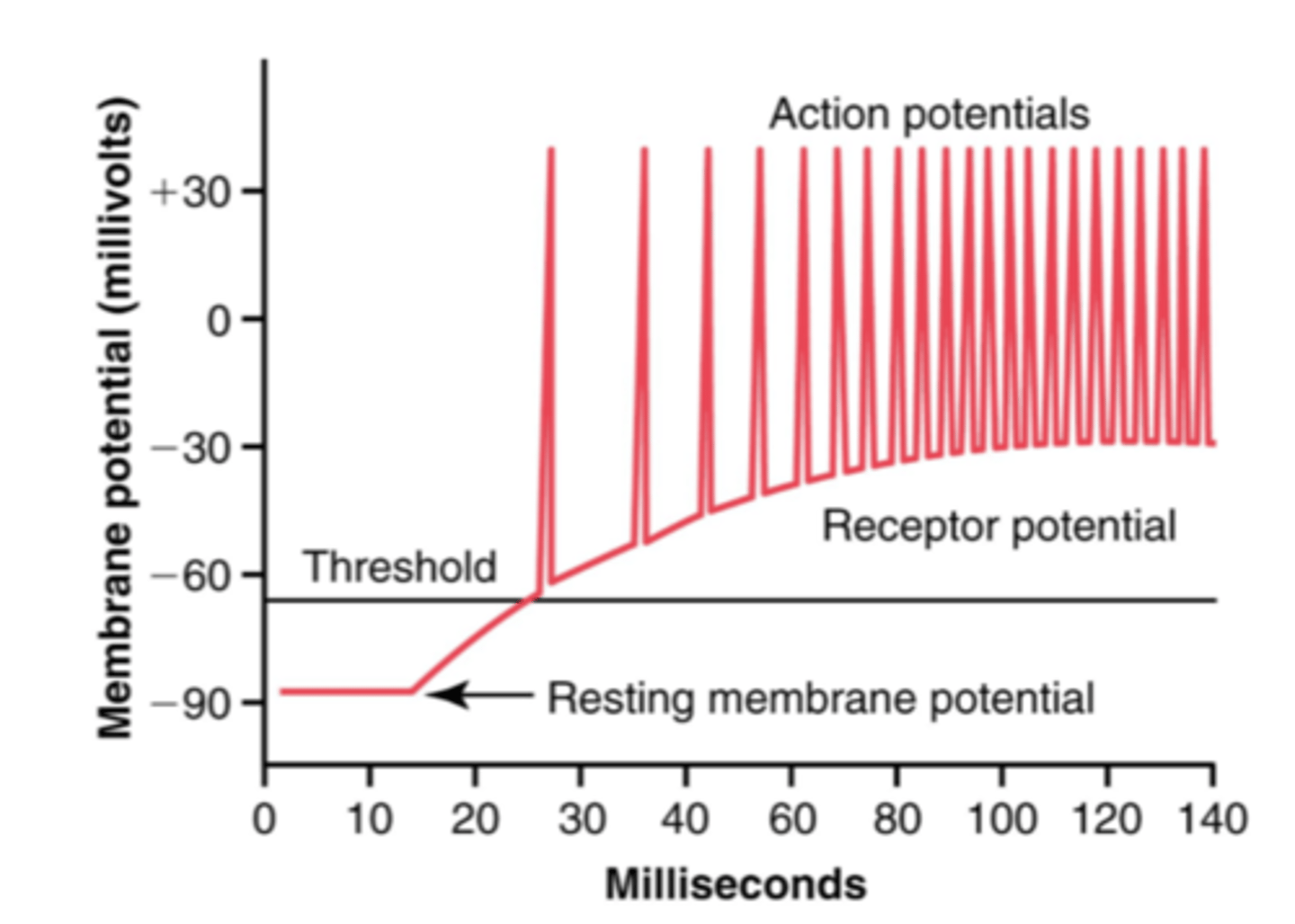
Receptor Potential of the Pacinian Corpuscle—
Example of Receptor Function
Note the (previous fig)
that the Pacinian corpuscle has a central nerve fiber extending through its core. Surrounding this central nerve fiber are multiple concentric capsule layers; thus, compression anywhere on the outside of the corpuscle will elongate, indent, or otherwise deform the central fiber.
This fig shows only the central fiber of the Pacinian corpuscle after all capsule layers but one have been removed. The tip of the central fiber inside the capsule is unmyelinated, but the fiber does become myelinated (the blue sheath shown in the figure) shortly before leaving the corpuscle to enter a peripheral sensory nerve.
This fig also shows the mechanism whereby a receptor potential is produced in the Pacinian corpuscle.
Observe the small area of the terminal fiber that has been deformed by compression of the corpuscle, and note that ion channels have opened in the membrane, allowing
positively charged sodium ions to diffuse to the interior of the fiber. This action creates increased positivity inside the fiber, called the "receptor potential." The receptor potential in turn induces a local circuit of current flow, shown by the arrows, that spreads along the nerve fiber.
At the first node of Ranvier, which lies inside the capsule of the Pacinian corpuscle, the local current flow depolarizes the fiber membrane at this node, which then sets off typical action potentials that are transmitted along the nerve fiber toward the central nervous system.
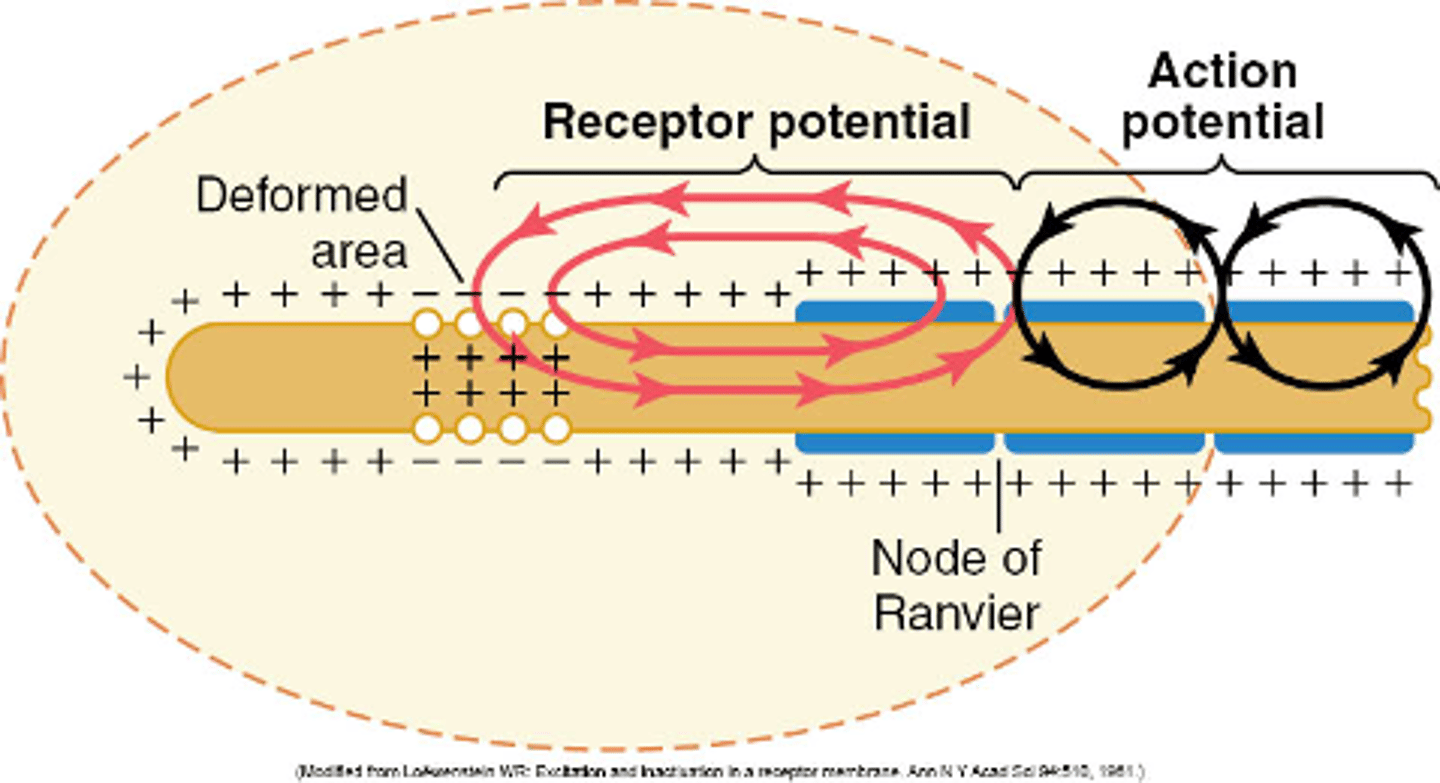
Relation Between Stimulus Intensity and the Receptor Potential
This fig shows the changing amplitude of the receptor potential caused by progressively stronger mechanical compression (increasing "stimulus strength") applied experimentally to the central core of a Pacinian corpuscle.
Note that the amplitude increases rapidly at first but then progressively less rapidly at high stimulus strength.
In turn, the frequency of repetitive action potentials transmitted from sensory receptors increases approximately in proportion to the increase in receptor potential.
Putting this principle together with the data in Fig one can see that very intense stimulation of the receptor causes progressively less and less additional increase in numbers of action potentials. This exceedingly important principle is applicable to almost all sensory receptors.
It allows the receptor to be sensitive to very weak sensory experience and yet not reach a maximum firing rate until the sensory experience is extreme.
This feature allows the receptor to have an extreme range of response—from very weak to very intense.
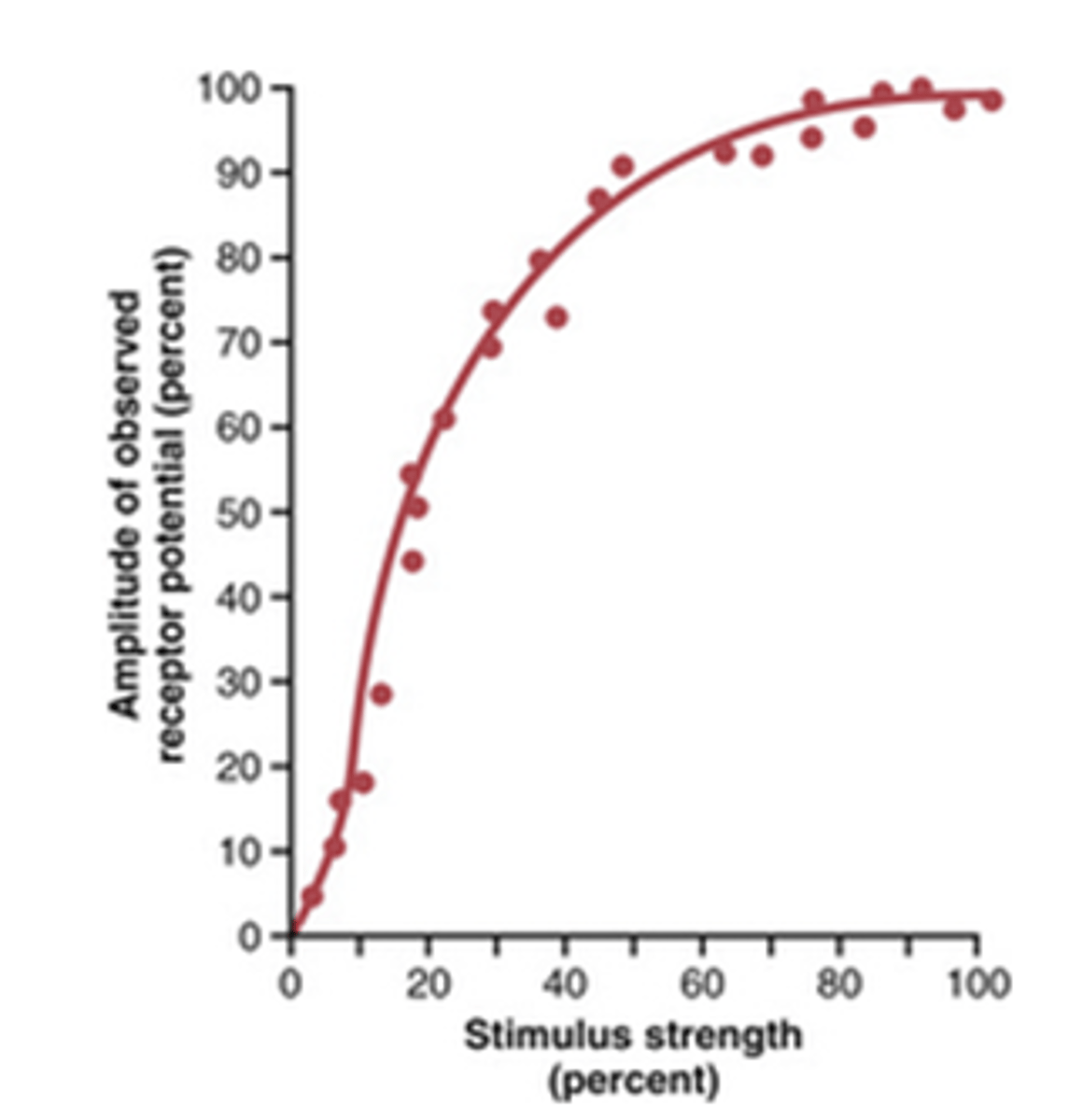
ADAPTATION OF RECEPTORS
Another characteristic of sensory receptors is that they adapt either partially or completely to any constant stimulus after a period of time.
That is, when a continuous sensory stimulus is applied, the receptor responds at a high impulse rate at first and then at a progressively slower rate until, finally, the rate of action potentials decreases to very few or to none at all
Graph
Fig 47-5 (Pg 590) shows typical adaptation of certain types of receptors. Note that the Pacinian corpuscle adapts very rapidly, hair receptors adapt within a second or so, and some joint capsule and muscle spindle receptors adapt slowly.
Some sensory receptors adapt to a far greater extent than others
Pacinian corpuscles adapt to "extinction" within a few 100th of a second, and the receptors at the bases of the hairs adapt to extinction within a second or more. It is probable that most mechanoreceptors eventually adapt almost completely.
Non-adapting receptor
Some receptor require hours or days adapt to extinction , and they are called "non adapting" receptors.
The longest measure time for almost complete adaptation of a mechanoreceptor is about 2 days, which is the adaptation time for many carotid and aortic baroreceptors; however, some physiologists believe that these specialized baroreceptors never fully adapt.
Some of the non-mechanoreceptors—the chemoreceptors
and pain receptors, for example—probably never adapt completely.
Mechanisms by Which Receptors Adapt
The mechanism of receptor adaptation is different for each type of receptor in much the same way that development of a receptor potential is an individual property
Mechanoreceptors- Pacinian corpuscle
Adaptation occurs in this receptor in two ways.
1) the Pacinian corpuscle is a viscoelastic structure, so that when a distorting force is suddenly applied to one side of the corpuscle, this force is instantly transmitted by the viscous component of the corpuscle directly to the same side of the central nerve fiber, thus eliciting a receptor potential. However, within a few hundredths of a second, the fluid within the corpuscle redistributes, and the receptor potential is no longer elicited. Thus, the receptor potential appears at the onset of compression but disappears within a small fraction of a second, even though the compression continues.
2 ) Much slower mechanism of adaptation of the Pacinian corpuscle results from a process called accommodation, which occurs in the nerve fiber itself.
That is, even if by chance the central core fiber should continue to be distorted, the tip of the nerve fiber gradually becomes accommodated to the stimulus. This probably results from progressive "inactivation" of the sodium channels in the nerve fiber membrane, which means that sodium current flow through the channels causes them to close gradually, an effect that seems to occur for all or most cell membrane sodium channels
These same two general mechanisms of adaptation also apply to the other types of mechanoreceptors.
That is, part of the adaptation results from readjustments in the structure of the receptor, and part results from an electrical type of accommodation in the terminal nerve fibril.
Slowly Adapting Receptors Detect Continuous Stimulus Strength— the "Tonic" Receptors
The slowly adapting receptors can continue to transmit information for many hours, or even days, they are called tonic receptors.
Slowly adapting receptors continue to transmit impulses to the brain as long as the stimulus is present (or at least for many minutes or hours).
Therefore, they keep the brain constantly apprised of the status of the body and its relation to its surroundings.
For example, impulses from the muscle spindles and Golgi tendon apparatuses allow the nervous system to know the status of muscle contraction and load on the muscle tendon at each instant.
Other slowly adapting receptors include the following:-
1) receptors of the macula in the vestibular apparatus;
(2)pain receptors;
(3) baroreceptors of the arterial tree; and
(4) chemoreceptors of the carotid and aortic bodies
Rapidly Adapting Receptors Detect Change in Stimulus Strength—
the "Rate Receptors," "Movement Receptors," or "Phasic Receptors
Receptors that adapt rapidly cannot be used to transmit a continuous signal because they are stimulated only when the stimulus strength changes. Yet, they react strongly while a change is actually taking place. Therefore, these receptors are called rate receptors, movement receptors, or phasic receptors.
Example Pacinian corpuscle, sudden pressure applied to the tissue excites this receptor for a few milliseconds, and then its excitation is over, even though the pressure continues. Later, however, it transmits a signal again when the pressure is released. In other words, the Pacinian corpuscle is exceedingly important in apprising the nervous system of rapid tissue deformations, but it is useless for transmitting information about constant conditions in the body
Predictive Function of the Rate Receptors
If the rate at which some change in the body's status is taking place is known, the state of the body a few seconds or even a few minutes later can be predicted.
For example, the receptors of the semicircular canals in the vestibular apparatus of the ear detect the rate at which the head begins to turn when a person runs around a curve.
Using this information, a person can predict how much he or she will turn within the next 2 seconds and can adjust the motion of the legs ahead of time to keep from losing balance.
Likewise , receptors located in or near the joints help detect the rates of movement of the different parts of the body.
For example, when a person is running, information from the joint rate receptors allows the nervous system to predict where the feet will be during any precise fraction of the next second.
Therefore, appropriate motor signals can be transmitted to the muscles of the legs to make any necessary anticipatory corrections in position so that the person will not fall. Loss of this predictive function makes it impossible for the person to run.
Nerve Fibers That Transmit Different Types of Signals and Their Physiological Classification
Some signals need to be transmitted to or from the central nervous system extremely rapidly; otherwise, the information would be useless. An example of this is the sensory signals that apprise the brain of the momentary positions of the legs at each fraction of a second during running. At the other extreme, some types of sensory information, such as that depicting prolonged aching pain, do not need to be transmitted rapidly, and thus slowly conducting fibers will suffice.
"general classification" and a "sensory nerve classification"
Nerve fibers come in all sizes, from 0.5 to 20 micrometers in diameter; the larger the diameter, the greater the conducting velocity. The range of conducting velocities is between 0.5 and 120 m/sec.
Few large myelinated fibers can transmit impulses at velocities as great as 120 m/sec, covering a distance that is longer than a football field in 1 second.
The smallest fibers transmit impulses as slowly as 0.5 m/sec, requiring about 2 seconds to go from the big toe to the spinal cord
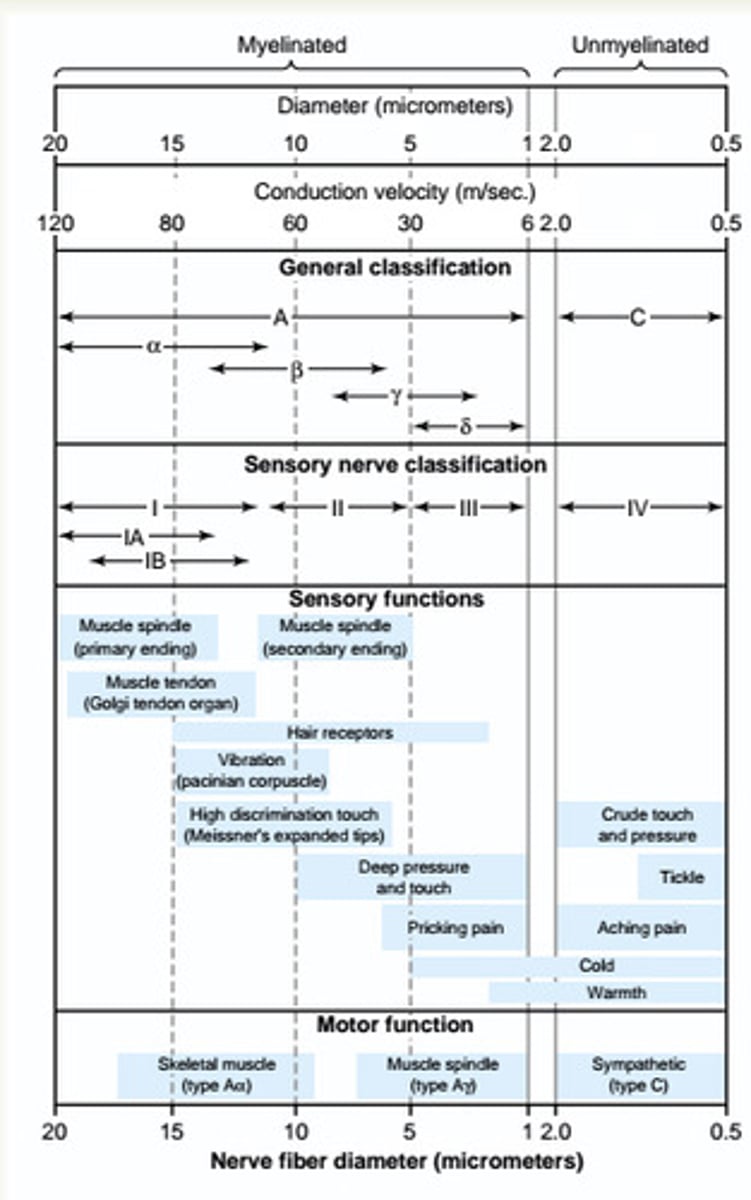
General Classification
The fibers are divided into types A and C;
the type A fibers are further subdivided into α, β, γ, and δ fibers.
Type A
T he type A fibers are further subdivided into α, β, γ, and δ fibers. Type A fibers are the typical large and medium-sized myelinated fibers of spinal nerves.
Type C
Type C fibers are the small unmyelinated nerve fibers that conduct impulses at low velocities. The C fibers constitute more than half of the sensory fibers in most peripheral nerves, as well as all the postganglionic autonomic fibers.
Alternative Classification Used by Sensory Physiologists.
Certain recording techniques have made it possible to separate the type Aα fibers into two subgroups, yet these same recording techniques cannot distinguish easily between Aβ and Aγ fibers. Therefore, the following classification is frequently used by sensory physiologists.
Groups
Group Ia.
Fibers from the annulospiral endings of muscle spindles (≈17 microns in diameter on average; these fibers are α-type A fibers in the general classification).
Group Ib.
Fibers from the Golgi tendon organs (≈16 micrometers in diameter on average; these fibers also are α-type A fibers).
Group II.
Fibers from most discrete cutaneous tactile receptors and from the flower-spray endings of the muscle spindles (≈8 micrometers in diameter on average; these fibers are β-and γ-type A fibers in the general classification).
Group III.
Fibers carrying temperature, crude touch, and pricking pain sensations (≈3 micrometers in diameter on average; they are δ-type A fibers in the general classification).
Group IV.
Unmyelinated fibers carrying pain, itch, temperature, and crude touch sensations (0.5-2 micrometers in diameter; they are type C fibers in the general classification).
SIGNAL INTENSITY TRANSMISSION IN NERVE TRACTS
One of the characteristics of each signal that always must be conveyed is signal intensity—for example, the intensity of pain. The different gradations of intensity can be transmitted either by using increasing numbers of parallel fibers or by sending more action potentials along a single fiber. These two mechanisms are called, respectively, spatial summation and temporal summation
Spatial Summation
Spatial summation, whereby increasing signal strength is transmitted by using progressively greater numbers of fibers. This figure shows a section of skin innervated by a large number of parallel pain fibers. Each of these fibers arborizes into hundreds of minute free nerve endings that serve as pain receptors. The entire cluster of fibers from one pain fiber frequently covers an area of skin as large as 5 cm in diameter. This area is called the receptor field of that fiber. The number of endings is large in the center of the field but diminishes toward the periphery. One can also see from the figure that the arborizing fibrils overlap those from other pain fibers. Therefore, a pinprick of the skin usually stimulates endings from many different pain fibers simultaneously. When the pinprick is in the center of the receptive field of a particular pain fiber, the degree of stimulation of that fiber is far greater than when it is in the periphery of the field because of the greater number
of free nerve endings in the middle of the field.
Thus, the lower part of Figure 47-7 shows three views of the cross section of the nerve bundle leading from the skin area. To the left is the effect of a weak stimulus, with only a single nerve fiber in the middle of the bundle stimulated strongly (represented by the red-colored fiber), whereas several adjacent fibers are stimulated weakly (half-red fibers). The other two views of the nerve cross section show the effect of a moderate stimulus and a strong stimulus, with progressively more fibers being stimulated. Thus, the stronger signals spread to more and more fibers, a phenomenon called spatial summation.

Temporal Summation.
A second means for transmitting signals of increasing strength is by increasing the frequency of nerve impulses in each fiber, called temporal summation. Fig 47-8 (592) demonstrates this phenomenon, showing a changing strength of signal in the upper part and the actual impulses transmitted by the nerve fiber in the lower part.
TRANSMISSION AND PROCESSING OF SIGNALS IN NEURONAL POOLS
The central nervous system is composed of thousands to millions of neuronal pools; some of these pools contain few neurons, whereas others have vast numbers.
For example, the entire cerebral cortex could be considered to be a single large neuronal pool. Other neuronal pools include the different basal ganglia and the specific nuclei in the thalamus, cerebellum, mesencephalon, pons, and medulla. Also, the entire dorsal gray matter of the spinal cord could be considered one long pool of neurons. Each neuronal pool has its own special organization that causes it to process signals in its own unique way,
thus allowing the total consortium of pools to achieve the multitude of functions of the nervous system. Yet, despite their differences in function, the pools also have many
similar principles of function, described in the following sections.
RELAYING OF SIGNALS THROUGH NEURONAL POOLS
Organization of Neurons for Relaying Signals
Fig is a schematic diagram of several neurons in a neuronal pool, showing input fibers to the left and "output" fibers to the right. Each input fiber divides hundreds to thousands of times, providing a thousand or more terminal fibrils that spread into a large area in the pool to synapse with dendrites or cell bodies of the neurons in the pool. The dendrites usually also arborize and spread hundreds to thousands of micrometers in the pool.
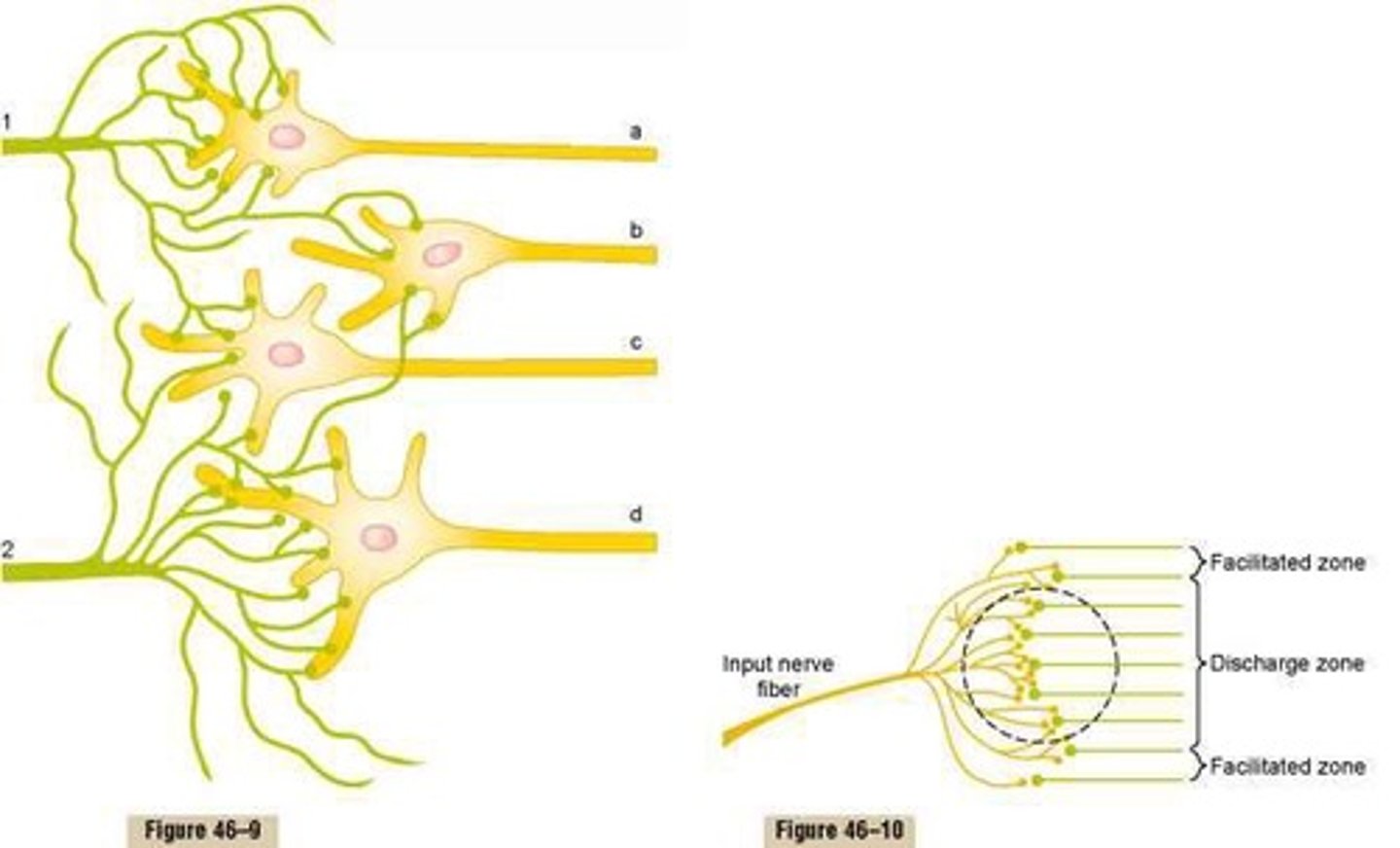
stimulatory field
The neuronal area stimulated by each incoming nerve fiber is called its stimulatory field. Note that large numbers of the terminals from each input fiber lie on the nearest neuron in its "field," but progressively fewer terminals
lie on the neurons farther away
Threshold and Subthreshold Stimuli—Excitation or Facilitation
Discharge of a single excitatory presynaptic terminal almost never causes an action potential in a postsynaptic neuron. Instead, large numbers of input terminals must discharge on the same neuron either simultaneously or in rapid succession to cause excitation.
For example, in Figure 47-9, let us assume that six terminals must discharge almost simultaneously to excite any one of the neurons.
Note that input fiber 1 has more than enough terminals to cause neuron at A discharge. The stimulus from input fiber 1 to this neuron is said to be an excitatory stimulus; it is also called a suprathreshold stimulus because it is above the threshold required for excitation.
Input fiber 1 also contributes terminals to neurons b and c, but not enough to cause excitation. Nevertheless, discharge of these terminals makes both these neurons more likely to be excited by signals arriving through other incoming nerve fibers.
Therefore, the stimuli to these neurons are said to be subthreshold, and the neurons are said to be facilitated. Similarly, for input fiber 2, the stimulus to neuron d is a suprathreshold stimulus, and the stimuli to neurons b and c are subthreshold, but facilitating, stimuli.
Figure 47-9 represents a highly condensed version of a neuronal pool because each input nerve fiber usually provides massive numbers of branching terminals to hundreds or thousands of neurons in its distribution "field," as shown in Figure 47-10.
Distribution field
In the central portion of the field in this figure, designated by the circled area, all the neurons are stimulated by the incoming fiber. Therefore, this is said to be the discharge zone of the incoming fiber, also called the excited zone or liminal zone. To each side, the neurons are facilitated but not excited; these areas are called the facilitated zone, also called the subthreshold zone or subliminal zone
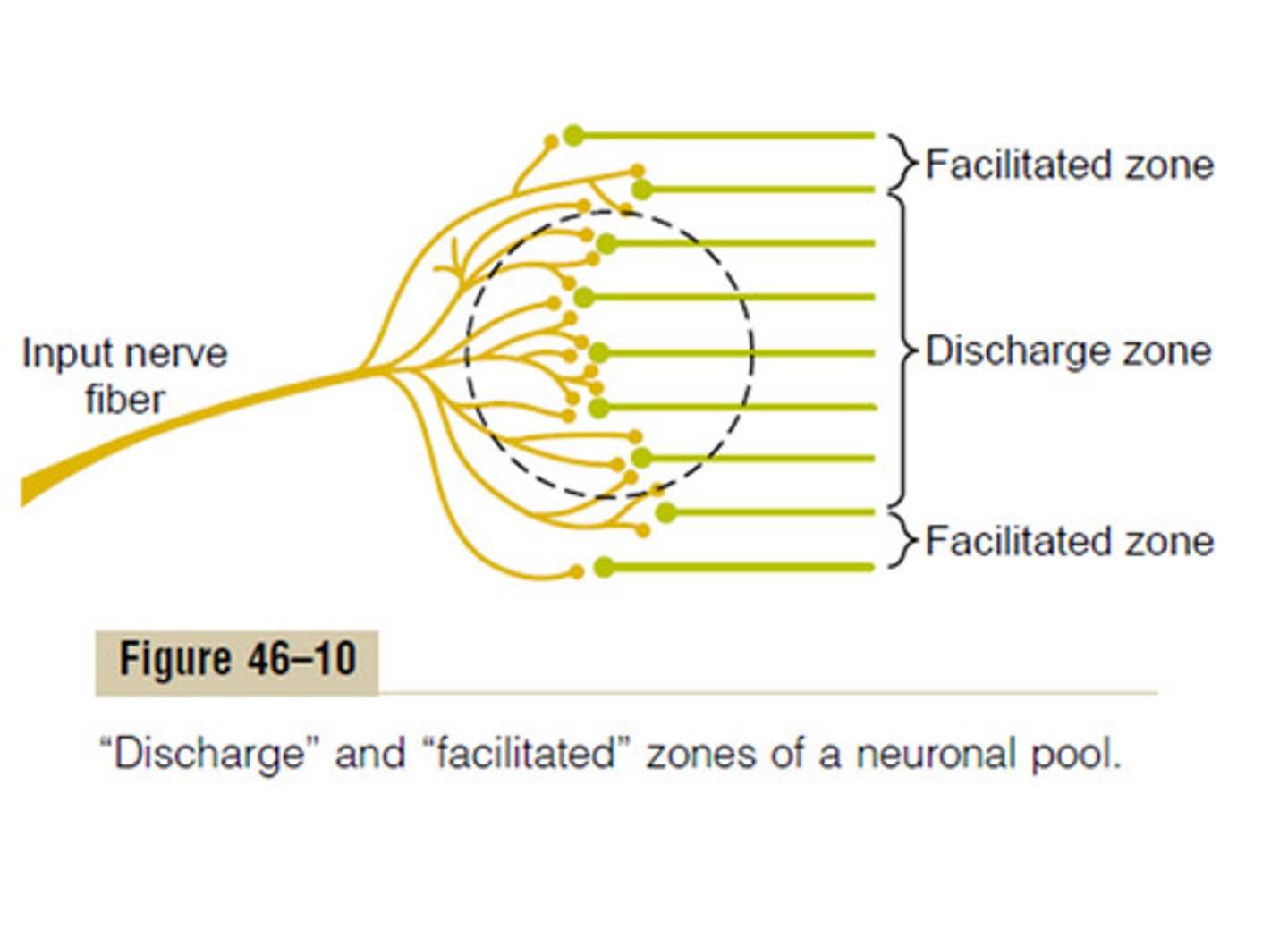
Inhibition of a Neuronal Pool
Some incoming fibers inhibit neurons, rather than exciting them. This mechanism is the opposite of facilitation, and the entire field of the inhibitory branches is called the inhibitory zone. The degree of inhibition in the center of this zone is great because of large numbers of endings in the center and becomes progressively less toward its edges.
Divergence of Signals Passing Through Neuronal Pools
Often, it is important for weak signals entering a neuronal pool to excite far greater numbers of nerve fibers leaving the pool. This phenomenon is called divergence. Two major types of divergence occur and have entirely different purposes
An amplifying type of divergence
An amplifying type of divergence is shown in Fig
Amplifying divergence means simply that an input signal spreads to an increasing number of neurons as it passes through successive orders of neurons in its path. This type of divergence is characteristic of the corticospinal pathway in its control of skeletal muscles, with a single large pyramidal cell in the motor cortex capable, under highly facilitated conditions, of exciting as many as 10,000 muscle fibers
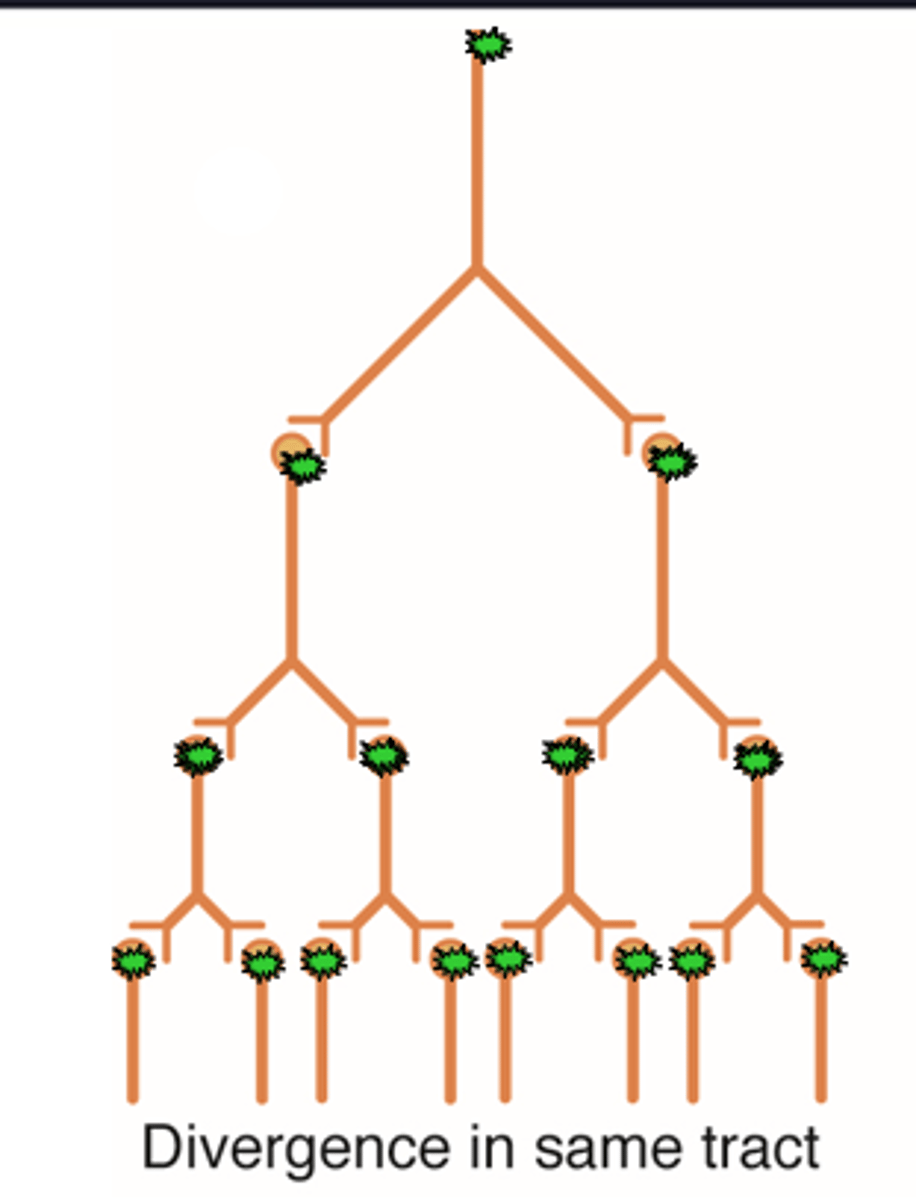
divergence into multiple tracts
In this case, the signal is transmitted in two directions from the pool.
Example, information transmitted up the dorsal columns of the spinal cord takes two courses in the lower part of the brain:
(1) into the cerebellum; and
(2) on through the lower regions of the brain to the thalamus and cerebral cortex.
Likewise, in the thalamus, almost all sensory information is relayed into still deeper structures of the thalamus and, at the same time, to discrete regions of the cerebral cortex.
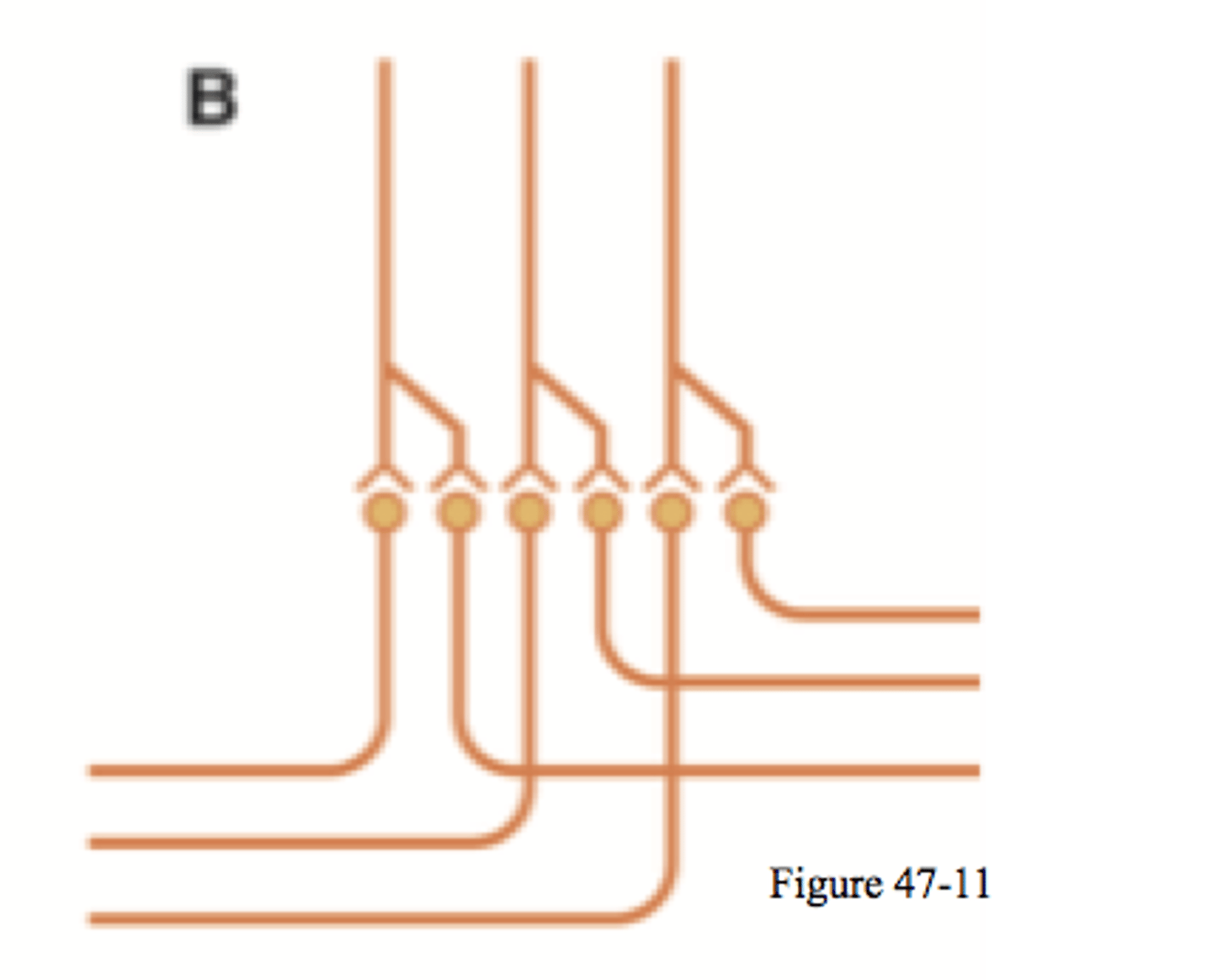
Convergence of Signals
Convergence means signals from multiple inputs uniting to
excite a single neuron. FigA shows convergence from a single source—That is, multiple terminals from a single incoming fiber tract terminate on the same neuron.
The importance of this type of convergence is that neurons are almost never excited by an action potential from a single input terminal. However, action potentials converging on the neuron from multiple terminals provide enough spatial summation to bring the neuron to the
threshold required for discharge
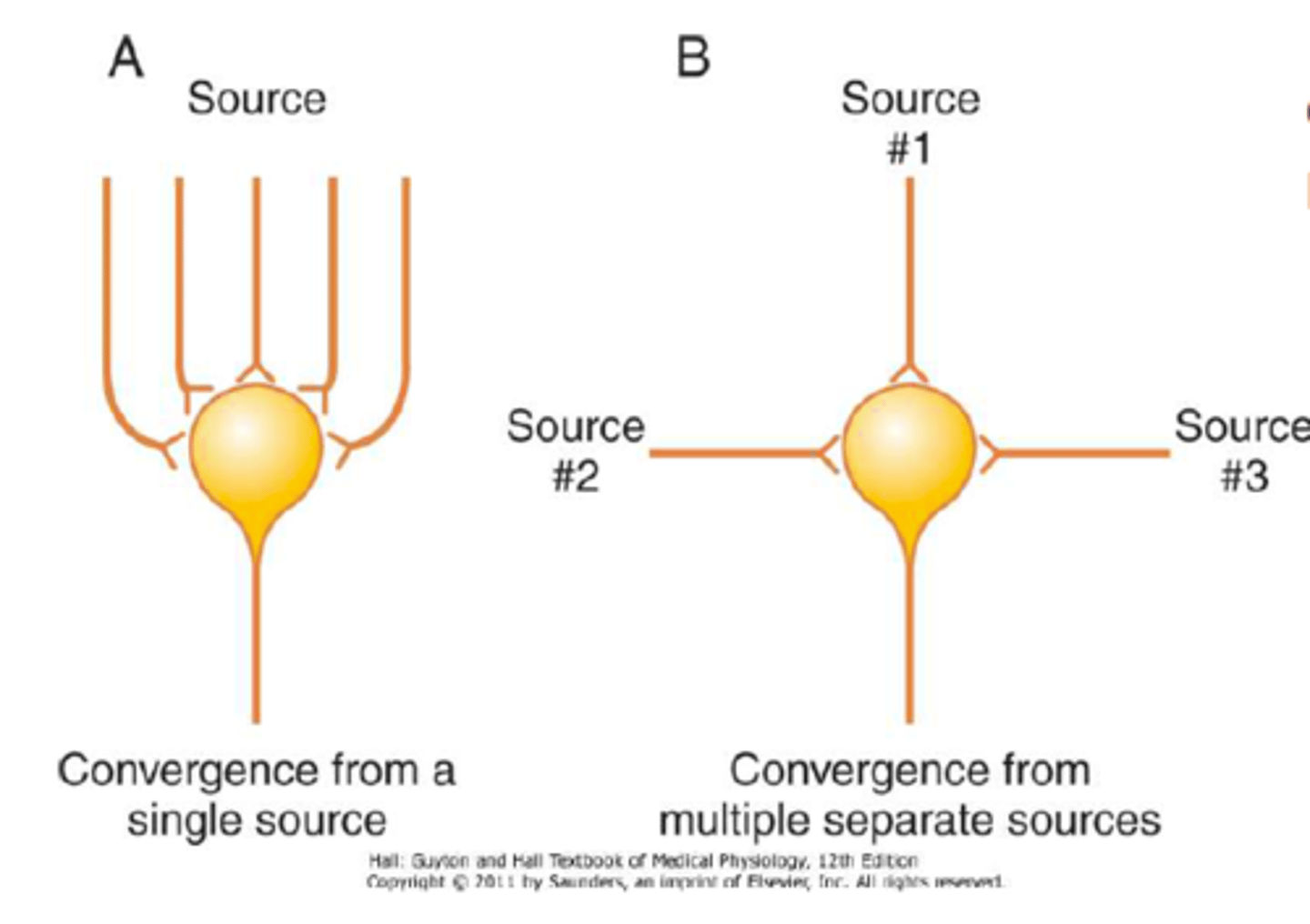
Convergence can also result from input signals (excitatory or inhibitory) from multiple source
FigB.
For example, the interneurons of the
spinal cord receive converging signals from the following:
(1) peripheral nerve fibers entering the cord;
(2) propriospinal fibers passing from one segment of the cord to another;
(3) corticospinal fibers from the cerebral cortex;
(4) several other long pathways descending from the brain into the spinal cord.
Then, the signals from the interneurons converge on the anterior motor neurons to control muscle function.
Such convergence allows summation of information from different sources, and the resulting response is a summated effect of all the different types of information. Convergence is one of the important means whereby the central nervous system correlates, summates, and sorts different types of information.
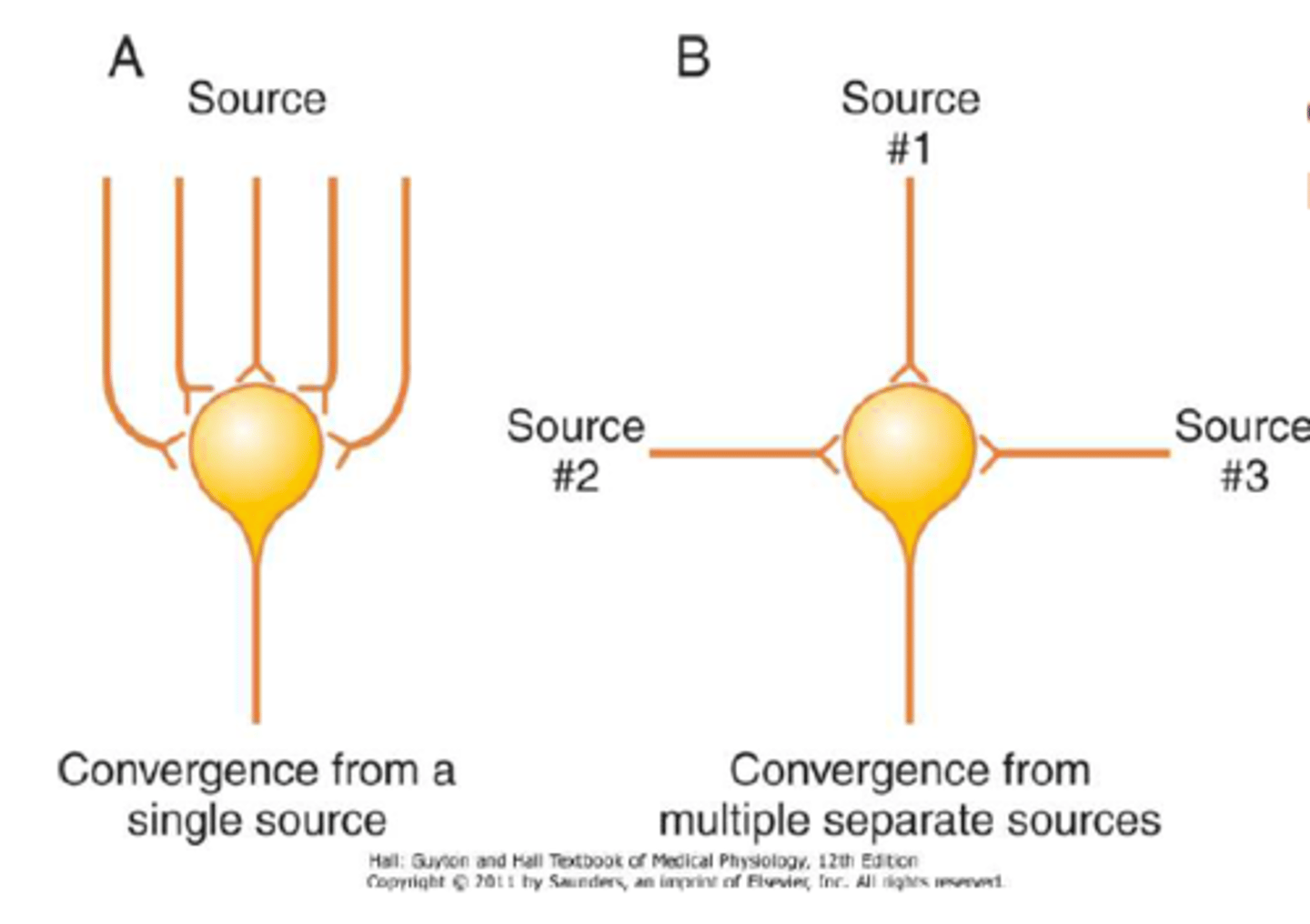
Neuronal Circuit With Both Excitatory and Inhibitory Output Signals-
Reciprocal inhibition circuit
Sometimes an incoming signal to a neuronal pool causes an output excitatory signal going in one direction and, at the same time, an inhibitory signal going elsewhere.
For example, at the same time that an excitatory signal is transmitted by one set of neurons in the spinal cord to cause forward movement of a leg, an inhibitory signal is transmitted through a separate set of neurons to inhibit the muscles on the back of the leg so that they will not oppose the forward movement.
This type of circuit is characteristic for controlling all antagonistic pairs of muscles; it is called the reciprocal inhibition circuit
Inhibitory circuit. Neuron 2 is an inhibitory neuron
Fig shows the means whereby the inhibition is achieved.
The input fiber directly excites the excitatory output pathway, but it stimulates an intermediate inhibitory neuron (neuron 2), which secretes a different type of transmitter substance to inhibit the second output pathway from the pool. This type of circuit is also important in preventing overactivity in many parts of the brain

PROLONGATION OF A SIGNAL BY A NEURONAL POOL—AFTERDISCHARGE
in many cases, a signal entering a pool causes a prolonged output discharge, called after-discharge, lasting a few milliseconds to as long as many minutes after the incoming signal is over.
Synaptic After-discharge
When excitatory synapses discharge on the surfaces of dendrites or soma of a neuron, a postsynaptic electrical potential develops in the neuron and lasts for many milliseconds, especially when some of the long-acting synaptic transmitter substances are involved. As long as this potential lasts, it can continue to excite the neuron, causing it to transmit a continuous train of output impulses.
Thus, as a result of this synaptic after-discharge mechanism
alone, it is possible for a single instantaneous input signal to cause a sustained signal output (a series of repetitive discharges) lasting for many milliseconds.
Reverberatory (Oscillatory) Circuit as a Cause of Signal Prolongation
One of the most important of all circuits in the entire nervous system is the reverberatory or oscillatory circuit. Such circuits are caused by positive feedback within the neuronal circuit that feeds back to re-excite the input of the same circuit. Consequently, once stimulated, the circuit may discharge repetitively for a long time.
Possible varieties of reverberatory circuits
The simplest, shown in FigA, involves only a single neuron. In this case, the output neuron sends a collateral nerve fiber back to its own dendrites or soma to restimulate itself. Although the importance of this type of circuit is not clear, theoretically, once the neuron discharges, the feedback stimuli could keep the neuron discharging for a protracted time thereafter.
FigB
shows a few additional neurons in the feedback circuit, which causes a longer delay between initial discharge and the feedback signal.
FigC
shows a more complex system in which both facilitatory
and inhibitory fibers impinge on the reverberating circuit.
A facilitatory signal enhances the intensity and frequency
of reverberation, whereas an inhibitory signal depresses
or stops the reverberation.
FigD
shows that most reverberating pathways are constituted of many parallel fibers. At each cell station, the terminal fibrils spread widely. In such a system, the total reverberating signal can be either weak or strong, depending on how many parallel nerve fibers are momentarily involved in the reverberation
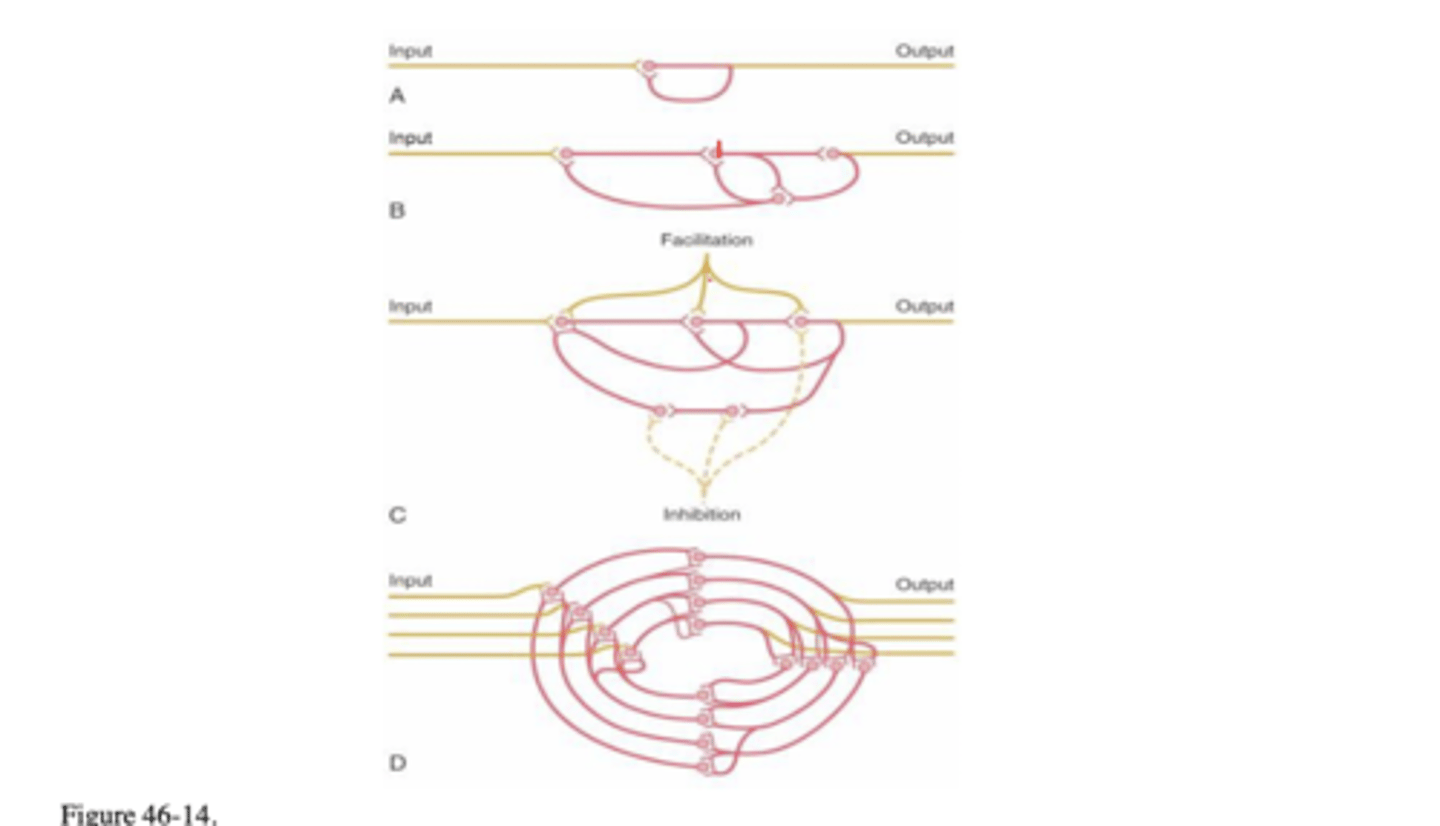
Signal Prolongation Characteristics of a Reverberatory Circuit
Fig47-15 (595)
shows output signals from a typical reverberatory circuit. The input stimulus may last only 1 ms or so, and yet the output can last for many mis or even minutes. The figure demonstrates that the intensity of the output signal usually increases to a high value early in reverberation and then
decreases to a critical point, at which it suddenly ceases
entirely. The cause of this sudden cessation of reverberation
is fatigue of synaptic junctions in the circuit. Fatigue beyond a certain critical level lowers the stimulation of the next neuron in the circuit below threshold level so that the circuit feedback is suddenly broken.
The duration of the total signal before cessation can
also be controlled by signals from other parts of the brain
that inhibit or facilitate the circuit. These patterns of output
signals are recorded from motor nerves exciting a muscle involved in a flexor reflex after pain stimulation of
the foot (as shown later in Figure 47-18).
Continuous Signal Output From Some Neuronal Circuits
Some neuronal circuits emit output signals continuously,
even without excitatory input signals. At least two mechanisms can cause this effect:
(1) continuous intrinsic neuronal discharge; and
(2) continuous reverberatory signals
Continuous Discharge Caused by Intrinsic Neuronal Excitability
Neurons, like other excitable tissues, discharge repetitively if their level of excitatory membrane potential rises above a certain threshold level. The membrane potentials of many neurons, even normally, are high enough to cause them to emit impulses continually. This phenomenon occurs especially in many of the neurons of the cerebellum, as well as in most of the interneurons of the spinal cord. The rates at which these cells emit impulses can be increased by excitatory signals or decreased by inhibitory signals; inhibitory signals often can decrease the rate of firing to zero.
Continuous Signals Emitted From Reverberating Circuits as a Means for Transmitting Information
A reverberating circuit that does not fatigue enough to stop
reverberation is a source of continuous impulses. Furthermore, excitatory impulses entering the reverberating pool can increase the output signal, whereas inhibition can decrease or even extinguish the signal.
Fig shows a continuous output signal from a pool of neurons. The pool may be emitting impulses because of intrinsic neuronal excitability or as a result of reverberation. Note that an excitatory input signal greatly increases the output signal, whereas an inhibitory input signal greatly decreases the output. Students who are familiar with radio transmitters will recognize this to be a carrier wave type of information transmission.
That is, the excitatory and inhibitory control signals are not the cause of the output signal, but they do control its changing level of intensity.
Note that this carrier wave system allows a decrease in signal intensity, as well as an increase, whereas up to this point, the types of information transmission we have discussed have been mainly positive information rather than negative information.
This type of information transmission is used by the autonomic nervous system to control such functions as vascular tone, gut tone, degree of constriction of the iris in the eye, and heart rate.
That is, the nerve excitatory signal to each of these areas can be either increased or decreased by accessory input signals into the reverberating neuronal pathway
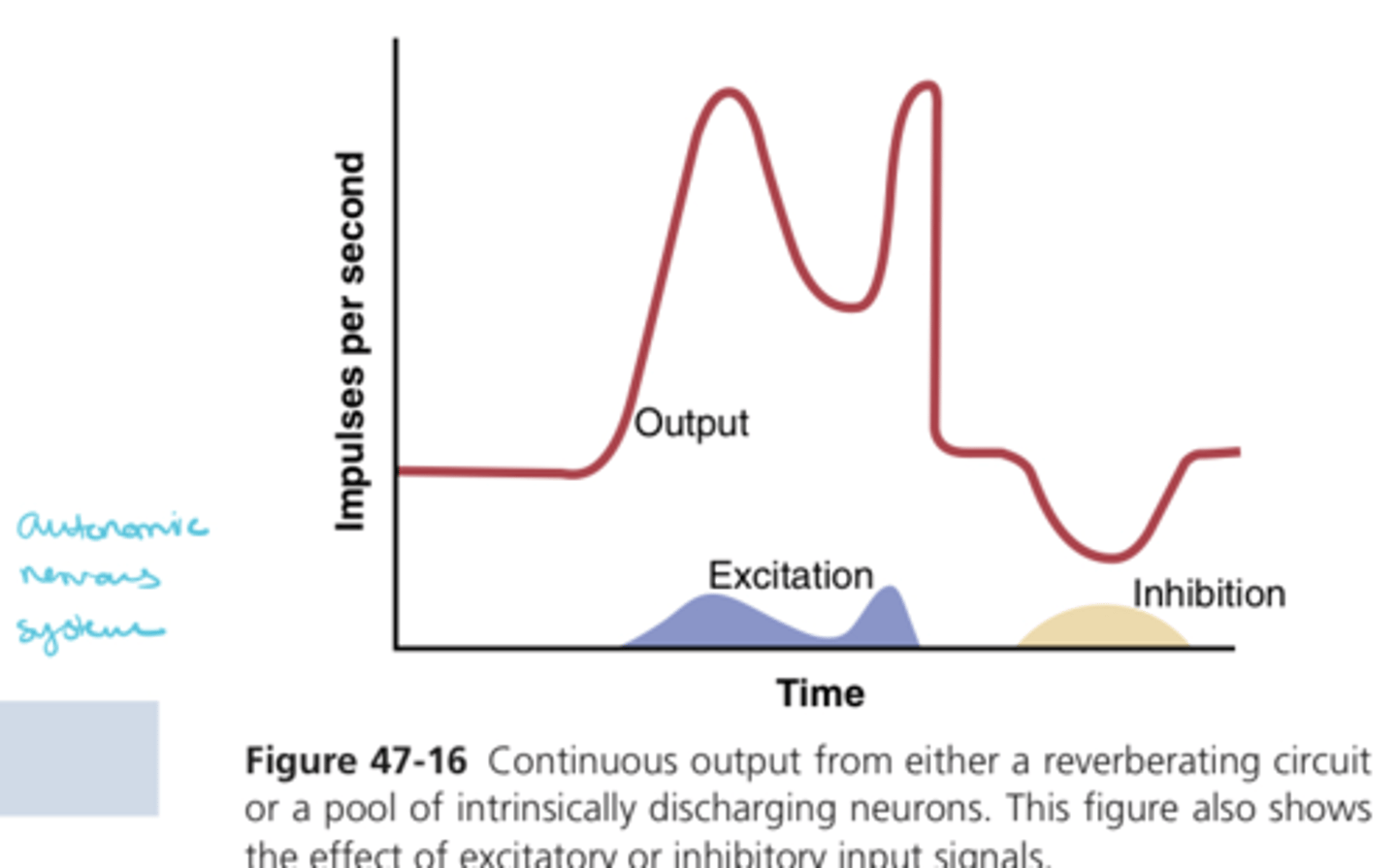
Rhythmical Signal Output
Many neuronal circuits emit rhythmical output signals for example, a rhythmical respiratory signal originates in the respiratory centers of the medulla and pons. This respiratory rhythmical signal continues throughout life. Other rhythmical signals, such as those that cause scratching movements by the hind leg of a dog or the walking movements of any animal, require input stimuli into the respective circuits to initiate the rhythmical signals. All or almost all rhythmical signals that have been studied experimentally have been found to result from reverberating circuits or a succession of sequential reverberating circuits that feed excitatory or inhibitory signals in a circular pathway from one neuronal pool to the next
Excitatory or inhibitory signals can also increase or decrease the amplitude of the rhythmical signal output.
Figure 47-17, for example, shows changes in the respiratory
signal output in the phrenic nerve. When the carotid
body is stimulated by arterial oxygen deficiency, both the
frequency and the amplitude of the respiratory rhythmical
output signal increase progressively.
INSTABILITY AND STABILITY OF NEURONAL CIRCUITS
Almost every part of the brain connects either directly or
indirectly with every other part, which creates a serious
challenge. If the first part excites the second, the second
the third, the third the fourth, and so on until finally the
signal re-excites the first part, then an excitatory signal
entering any part of the brain would set off a continuous
cycle of re-excitation of all parts. If this cycle should occur,
the brain would be inundated by a mass of uncontrolled
reverberating signals—signals that would be transmitting
no information but, nevertheless, would be consuming
the circuits of the brain so that none of the informational
signals could be transmitted. Such an effect occurs in
widespread areas of the brain during epileptic seizures
How does the central nervous system prevent this effect from happening all the time?
The answer lies mainly in two basic mechanisms that function throughout the central nervous system:
(1) inhibitory circuits; and
(2) fatigue of synapses.
INHIBITORY CIRCUITS AS A MECHANISM FOR STABILIZING NERVOUS SYSTEM FUNCTION
Two types of inhibitory circuits in widespread areas of
the brain help prevent excessive spread of signals:
(1)inhibitory feedback circuits that return from the termini of pathways back to the initial excitatory neurons of the same pathways (these circuits occur in virtually all sensory nervous pathways and inhibit either the input neurons or the intermediate neurons in the sensory pathway when the termini become overly excited); and
(2) some neuronal pools that exert gross inhibitory control over widespread areas of the brain (e.g., many of the basal ganglia exert inhibitory influences throughout the muscle control system).
SYNAPTIC FATIGUE AS A MEANS OF STABILIZING THE NERVOUS SYSTEM
Synaptic fatigue means simply that synaptic transmission becomes progressively weaker the more prolonged and more intense the period of excitation.
Figure 47-18 shows three successive records of a flexor reflex elicited in an animal caused by inflicting pain in the footpad of the paw.
Note in each record that the strength of contraction progressively "decrements"—that is, its strength diminishes.
Much of this effect is caused by fatigue of synapses in the flexor reflex circuit. Furthermore, the shorter the interval between successive flexor reflexes, the less the intensity of the subsequent reflex response
Automatic Short-Term Adjustment of Pathway Sensitivity by the Fatigue Mechanism
Those neuronal pathways that are overused usually become rapidly fatigued, so their sensitivities decrease.
Conversely, those that are underused become rested, and their sensitivities increase Thus, fatigue and recovery from fatigue constitute an important short-term means of moderating the sensitivities of the different nervous system circuits. These functions help keep the circuits operating in a range of sensitivity that allows effective function
Long-Term Changes in Synaptic Sensitivity Caused by Automatic Downregulation or Upregulation of Synaptic Receptors
The long-term sensitivities of synapses can be changed tremendously by upregulating the number of receptor proteins at the synaptic sites when there is underactivity and downregulating the receptors when there is overactivity.
The mechanism for this process is as follows. Receptor proteins are being formed constantly by the endoplasmic reticular-Golgi apparatus system and are constantly being inserted into the receptor neuron synaptic membrane. However, when the synapses are overused so that excesses of transmitter substance combine with the receptor proteins, many of these receptors are inactivated and removed from the synaptic membrane.
It is indeed fortunate that upregulation and downregulation of receptors, as well as other control mechanisms for adjusting synaptic sensitivity, continually adjust the sensitivity in each circuit to almost the exact level required for proper function.
How serious it would be if the sensitivities of only a few of these circuits were abnormally high?
One might then expect almost continual muscle cramps, seizures, psychotic disturbances, hallucinations, mental tension, or other nervous disorders. Fortunately, the automatic controls normally readjust the sensitivities of the circuits back to controllable ranges of reactivity any time the circuits begin to be too active or too depressed.